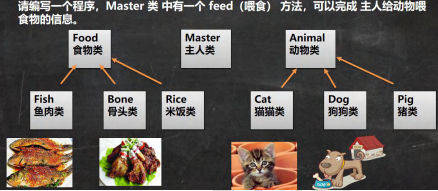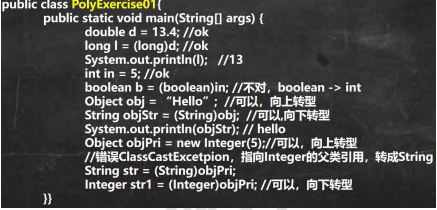1 先看一个问题

使用传统的方法来解决(private 属性)
传统的方法带来的问题是什么? 如何解决?
问题是: 代码的复用性不高,而且不利于代码维护
解决方案: 引出我们要讲解的多态
package com.yt.poly;
public class Ploy01 {
public static void main(String[] args) {
Master master = new Master("tom");
Dog dog = new Dog("dahuang");
Bone bone = new Bone("bone");
master.feed(dog,bone);
Cat cat = new Cat("xiaomiao");
Fish fish = new Fish("黄花鱼");
master.feed(cat,fish);
}
}
//7.创建主人master类
class Master {
private String name;
public Master(String name) {
this.name = name;
}
//使用多态机制,可以统一的管理主人喂食的问题
//animal 编译类型是Animal,可以指向(接收) Animal子类的对象
//food 编译类型是Food ,可以指向(接收) Food子类的对象
public void feed(Animal animal, Food food) {
System.out.println("主人 " + name + " 给 " + animal.getName() + " 吃 " + food.getName());
}
// public void feed(Dog dog, Bone bone){
// System.out.println("主人" + name + " 给" + dog.getName() + " 喂" + bone.getName());
// }
// public void feed(Cat cat, Fish fish){
// System.out.println("主人" + name + " 给" + cat.getName() + " 喂" + fish.getName());
// }
//如果动物很多,食物很多
//===> feed 方法很多,不利于管理和维护
//Pig --> Rice
//Tiger ---> meat ...
//...
public String getName() {
return name;
}
public void setName(String name) {
this.name = name;
}
}
//6.创建Dog类,继承Animal类
class Dog extends Animal {
public Dog(String name) {
super(name);
}
}
//5.创建Cat类,继承Animal类
class Cat extends Animal {
public Cat(String name) {
super(name);
}
}
//4.创建Animal类
class Animal {
private String name;
public Animal(String name) {
this.name = name;
}
public String getName() {
return name;
}
public void setName(String name) {
this.name = name;
}
}
//3.创建Bone类,继承食物Food类
class Bone extends Food {
public Bone(String name) {
super(name);
}
}
//2.创建Fish类,继承食物Food类
class Fish extends Food {
public Fish(String name) {
super(name);
}
// @Override
// public String getName() {
// return name;
// }
//
// @Override
// public void setName(String name) {
// this.name = name;
// }
}
//1.创建食物类
class Food {
private String name;
public Food(String name) {
this.name = name;
}
public String getName() {
return name;
}
public void setName(String name) {
this.name = name;
}
}2 基本介绍
多[多种]态[状态]
方法或对象具有多种形态。
是面向对象的第三大特征,多态是建立在封装和继承基础之上的。
3.方法的多态
重载方法和重写方法
public class PloyMethod {
public static void main(String[] args) {
//方法重载体现多态
A a = new A();
//这里我们传入不同的参数,就会调用不同sum方法,就体现多态
System.out.println(a.sum(10, 20));
System.out.println(a.sum(10, 20, 30));
//方法重写体现多态
B b = new B();
a.say();
b.say();
}
}
class B { //父类
public void say() {
System.out.println("B say() 方法被调用...");
}
}
class A extends B {//子类
public int sum(int n1, int n2){//和下面sum 构成重载
return n1 + n2;
}
public int sum(int n1, int n2, int n3){
return n1 + n2 + n3;
}
public void say() {
System.out.println("A say() 方法被调用...");
}
}4.对象的多态(重难点)
一定要背下来的话:
- 一个对象的编译类型和运行类型可以不一致;
- 编译类型在定义对象时就确定了,不能改变;
- 运行类型是可以变化的;(看堆里面的对象)
- 编译类型看定义时 = 号的左边,运行类型看 = 号的右边;(编译看左,运行看右)
1.什么叫编译类型?什么叫运行类型呢?

可以让父类的一个引用指向子类的一个对象。
public class PolyObject {
public static void main(String[] args) {
//体验对象多态特点
//animal 编译类型就是 Animal , 运行类型 Dog
Animal animal = new Dog();
//因为运行时 , 执行到该行时,animal运行类型是Dog,所以cry就是Dog的cry
animal.cry(); //小狗汪汪叫
//animal 编译类型 Animal,运行类型就是 Cat
animal = new Cat();
animal.cry(); //小猫喵喵叫
}
}
public class Animal {
public void cry() {
System.out.println("Animal cry() 动物在叫....");
}
}
public class Cat extends Animal {
public void cry() {
System.out.println("Cat cry() 小猫喵喵叫...");
}
}
public class Dog extends Animal {
public void cry() {
System.out.println("Dog cry() 小狗汪汪叫...");
}
}5.多态细节讨论
-
多态的前提是:两个对象(类)存在继承关系
-
多态的向上转型:

特点1:为什么不能调用子类中特有成员?因为在编译阶段,能调用哪些成员,是由编译类型来决定的。但是在运行时,又要从子类开始查找方法或者属性。
- 多态向下转型:

查看类中有的属性和方法

public class PolyDetail {
public static void main(String[] args) {
//向上转型: 父类的引用指向了子类的对象
//语法:父类类型引用名 = new 子类类型();
Animal animal = new Cat();
Object obj = new Cat();//可以吗? 可以 Object 也是 Cat的父类
//向上转型调用方法的规则如下:
//(1)可以调用父类中的所有成员(需遵守访问权限)
//(2)但是不能调用子类的特有的成员
//(#)因为在编译阶段,能调用哪些成员,是由编译类型来决定的
//animal.catchMouse();错误
//(4)最终运行效果看子类(运行类型)的具体实现, 即调用方法时,按照从子类(运行类型)开始查找方法
//,然后调用,规则我前面我们讲的方法调用规则一致。
animal.eat();//猫吃鱼..
animal.run();//跑
animal.show();//hello,你好
animal.sleep();//睡
//老师希望,可以调用Cat的 catchMouse方法
//多态的向下转型
//(1)语法:子类类型 引用名 =(子类类型)父类引用;
//问一个问题? cat 的编译类型 Cat,运行类型是 Cat
Cat cat = (Cat) animal;
cat.catchMouse();//猫抓老鼠
//(2)要求父类的引用必须指向的是当前目标类型的对象
Dog dog = (Dog) animal; //可以吗?编译时正确,运行时错误,抛出ClassCastException类型转换异常
System.out.println("ok~~");
}
}
public class Animal {
String name = "动物";
int age = 10;
public void sleep(){
System.out.println("睡");
}
public void run(){
System.out.println("跑");
}
public void eat(){
System.out.println("吃");
}
public void show(){
System.out.println("hello,你好");
}
}
public class Cat extends Animal {
public void eat(){//方法重写
System.out.println("猫吃鱼");
}
public void catchMouse(){//Cat特有方法
System.out.println("猫抓老鼠");
}
}
public class Dog extends Animal {//Dog是Animal的子类
}- 属性没有重写之说!属性的值看编译类型;(注意和方法的调用规则进行区分,因为方法是可以重写的)
public class PolyDetail02 {
public static void main(String[] args) {
//属性没有重写之说!属性的值看编译类型
Base base = new Sub();//向上转型
System.out.println(base.count);// ? 看编译类型 10
Sub sub = new Sub();
System.out.println(sub.count);//? 20
}
}
class Base { //父类
int count = 10;//属性
}
class Sub extends Base {//子类
int count = 20;//属性
}- instanceOf 比较操作符,用于判断对象的运行类型是否为 XX 类型或 XX 类型的子类型
public class PolyDetail03 {
public static void main(String[] args) {
BB bb = new BB();
System.out.println(bb instanceof BB);// true
System.out.println(bb instanceof AA);// true
//aa 编译类型 AA, 运行类型是BB
//BB是AA子类
AA aa = new BB();
// true
// true
System.out.println(aa instanceof AA);
System.out.println(aa instanceof BB);
Object obj = new Object();
System.out.println(obj instanceof AA);//false
String str = "hello";
//System.out.println(str instanceof AA);
System.out.println(str instanceof Object);//true
}
}
class AA {} //父类
class BB extends AA {}//子类6.练习1
请说出下面的每条语言,哪些是正确的,哪些是错误的,为什么?


7.java 的动态绑定机制(非常非常重要)
Java 重要特性: 动态绑定机制
1.当调用对象方法的时候,该方法会和该对象的内存地址/运行类型绑定;(方法的调用是从运行内存开始的)
2.当调用对象属性时,没有动态绑定机制,哪里声明,哪里使用。
public class DynamicBinding {
public static void main(String[] args) {
//a 的编译类型 A, 运行类型 B
A a = new B();//向上转型
System.out.println(a.sum());//?40 -> 30
System.out.println(a.sum1());//?30-> 20
}
}
class A {//父类
public int i = 10;
//动态绑定机制:
public int sum() {//父类sum()
return getI() + 10;//20 + 10
}
public int sum1() {//父类sum1()
return i + 10;//10 + 10
}
public int getI() {//父类getI
return i;
}
}
class B extends A {//子类
public int i = 20;
// public int sum() {
// return i + 20;
// }
public int getI() {//子类getI()
return i;
}
// public int sum1() {
// return i + 10;
// }
}8.多态的应用-多态数组
数组的定义类型为父类类型,里面保存的实际元素类型为子类类型。
应用实例:现有一个继承结构如下:要求创建 1 个 Person 对象、2 个 Student 对象和 2 个 Teacher 对象, 统一放在数组 中,并调用每个对象 say 方法.
应用实例升级:如何调用子类特有的方法,比如 Teacher 有一个 teach , Student 有一个 study 怎么调用?
使用instanceof来判断。
public class PloyArray {
public static void main(String[] args) {
//应用实例:现有一个继承结构如下:要求创建1个Person对象、
// 2个Student 对象和2个Teacher对象, 统一放在数组中,并调用每个对象say方法
Person[] persons = new Person[5];
persons[0] = new Person("jack", 20);
persons[1] = new Student("mary", 18, 100);
persons[2] = new Student("smith", 19, 30.1);
persons[3] = new Teacher("scott", 30, 20000);
persons[4] = new Teacher("king", 50, 25000);
//循环遍历多态数组,调用say
for (int i = 0; i < persons.length; i++) {
//老师提示: person[i] 编译类型是 Person ,运行类型是是根据实际情况有JVM来判断
System.out.println(persons[i].say());//动态绑定机制
//这里大家聪明. 使用 类型判断 + 向下转型.
if(persons[i] instanceof Student) {//判断person[i] 的运行类型是不是Student
Student student = (Student)persons[i];//向下转型
student.study();
//小伙伴也可以使用一条语句 ((Student)persons[i]).study();
} else if(persons[i] instanceof Teacher) {
Teacher teacher = (Teacher)persons[i];
teacher.teach();
} else if(persons[i] instanceof Person){
//System.out.println("你的类型有误, 请自己检查...");
} else {
System.out.println("你的类型有误, 请自己检查...");
}
}
public class Person {//父类
private String name;
private int age;
public Person(String name, int age) {
this.name = name;
this.age = age;
}
public String getName() {
return name;
}
public void setName(String name) {
this.name = name;
}
public int getAge() {
return age;
}
public void setAge(int age) {
this.age = age;
}
public String say() {//返回名字和年龄
return name + "\t" + age;
}
}
public class Student extends Person {
private double score;
public Student(String name, int age, double score) {
super(name, age);
this.score = score;
}
public double getScore() {
return score;
}
public void setScore(double score) {
this.score = score;
}
//重写父类say
@Override
public String say() {
return "学生 " + super.say() + " score=" + score;
}
//特有的方法
public void study() {
System.out.println("学生 " + getName() + " 正在学java...");
}
}
public class Teacher extends Person {
private double salary;
public Teacher(String name, int age, double salary) {
super(name, age);
this.salary = salary;
}
public double getSalary() {
return salary;
}
public void setSalary(double salary) {
this.salary = salary;
}
//写重写父类的say方法
@Override
public String say() {
return "老师 " + super.say() + " salary=" + salary;
}
//特有方法
public void teach() {
System.out.println("老师 " + getName() + " 正在讲java课程...");
}
}9.多态的应用-多态参数
方法定义的形参类型为父类类型,实参类型允许为子类类型
应用案例:

public class PloyParameter {
public static void main(String[] args) {
Worker tom = new Worker("tom", 2500);
Manager milan = new Manager("milan", 5000, 200000);
PloyParameter ployParameter = new PloyParameter();
ployParameter.showEmpAnnual(tom);
ployParameter.showEmpAnnual(milan);
ployParameter.testWork(tom);
ployParameter.testWork(milan);
}
//showEmpAnnual(Employee e)
//实现获取任何员工对象的年工资,并在main方法中调用该方法 [e.getAnnual()]
public void showEmpAnnual(Employee e) {
System.out.println(e.getAnnual());//动态绑定机制.
}
//添加一个方法,testWork,如果是普通员工,则调用work方法,如果是经理,则调用manage方法
public void testWork(Employee e) {
if(e instanceof Worker) {
((Worker) e).work();//有向下转型操作
} else if(e instanceof Manager) {
((Manager) e).manage();//有向下转型操作
} else {
System.out.println("不做处理...");
}
}
}
public class Employee {
private String name;
private double salary;
public Employee(String name, double salary) {
this.name = name;
this.salary = salary;
}
//得到年工资的方法
public double getAnnual() {
return 12 * salary;
}
public String getName() {
return name;
}
public void setName(String name) {
this.name = name;
}
public double getSalary() {
return salary;
}
public void setSalary(double salary) {
this.salary = salary;
}
}
public class Manager extends Employee{
private double bonus;
public Manager(String name, double salary, double bonus) {
super(name, salary);
this.bonus = bonus;
}
public double getBonus() {
return bonus;
}
public void setBonus(double bonus) {
this.bonus = bonus;
}
public void manage() {
System.out.println("经理 " + getName() + " is managing");
}
//重写获取年薪方法
@Override
public double getAnnual() {
return super.getAnnual() + bonus;
}
}
public class Worker extends Employee {
public Worker(String name, double salary) {
super(name, salary);
}
public void work() {
System.out.println("普通员工 " + getName() + " is working");
}
@Override
public double getAnnual() { //因为普通员工没有其它收入,则直接调用父类方法
return super.getAnnual();
}
}




















 260
260











 被折叠的 条评论
为什么被折叠?
被折叠的 条评论
为什么被折叠?








